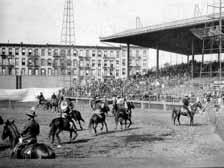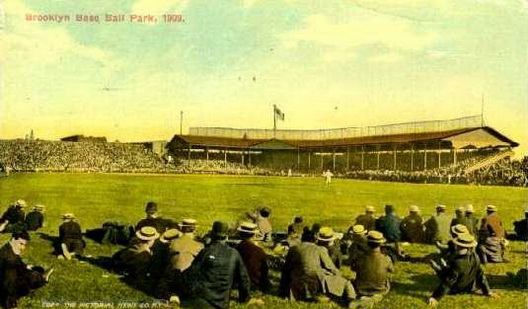With the baseball postseason in full swing, we wanted to reveal a little local lore. At the beginning of this year, it was announced that moves were underway to change the name of J. J. Byrne Park to Washington Park—actually back to Washington Park. The interesting thing is that, over the years, there have been three Washington Parks (all major league baseball parks) at two different locations diagonally opposite each other at 3rd Street and 4th Avenue. The first Washington Park was where J.J. Byrne is now – bounded by 3rd and 5th Streets and 4th and 5th Avenues. The story behind this one is fairly well known. The Old Stone House on the property served as a temporary headquarters for George Washington during the Battle of Brooklyn and thus inspired the name. The ballpark, on these same grounds, was the home of the Brooklyn baseball club from 1883-1889. The team was then called the “Atlantics,” which started as minor league team and joined the American Association in 1884, switching to the National League in 1890. Since trolley tracks ran near the ballpark, they became the inspiration for a nickname for the team that eventually stuck – “Trolley Dodgers.” The entire stadium burned to the ground in 1889 and was rebuilt. In 1891, the team split its time between Washington Park and Eastern Park (what is now Pitkin and Sutter Avenues and Van Sinderen and Powell Streets), moving there full-time in 1892. It was a little too far east for the fans’ convenience, and was abandoned after six poorly attended seasons.
 The second Washington Park was bound by 1st and 3rd Streets and 3rd and 4th Avenues. It sat 18,800 and consisted of a covered grandstand behind the infield and an uncovered stand down the right field line. The Brooklyn National Leaguers were often called the “Superbas” as well as the “Dodgers” and moved into this ballpark in 1898 (pictured here). They played there for the next 15 seasons, their last game occurring on October 5, 1912. In fact, In October 1889, 111 years ago, the first “subway” series was played a between the New York Giants and the Brooklyn “Bridegrooms” (their name that season) at this park. It would be the last World Series until 1903. In the meantime, owner Charles Ebbets had been slowly investing in property in an undeveloped section of Flatbush called “Pigtown” which would eventually become Ebbets Field. In 1913, the “Dodgers” abandoned Washington Park for their new home. Note: Charles Ebbets is buried in Green-Wood Cemetery. Ruth Edebohls will be giving a tour of the cemetery titled “Written in Stone: Tales of Green-Wood” on Sunday, November 9th at 1 PM for the Center for the Urban Environment.
The second Washington Park was bound by 1st and 3rd Streets and 3rd and 4th Avenues. It sat 18,800 and consisted of a covered grandstand behind the infield and an uncovered stand down the right field line. The Brooklyn National Leaguers were often called the “Superbas” as well as the “Dodgers” and moved into this ballpark in 1898 (pictured here). They played there for the next 15 seasons, their last game occurring on October 5, 1912. In fact, In October 1889, 111 years ago, the first “subway” series was played a between the New York Giants and the Brooklyn “Bridegrooms” (their name that season) at this park. It would be the last World Series until 1903. In the meantime, owner Charles Ebbets had been slowly investing in property in an undeveloped section of Flatbush called “Pigtown” which would eventually become Ebbets Field. In 1913, the “Dodgers” abandoned Washington Park for their new home. Note: Charles Ebbets is buried in Green-Wood Cemetery. Ruth Edebohls will be giving a tour of the cemetery titled “Written in Stone: Tales of Green-Wood” on Sunday, November 9th at 1 PM for the Center for the Urban Environment.
Washington Park #3 (built at the same site as Washington Park #2) was rebuilt in steel and concrete when the Brooklyn “Tip-Tops” (named after a loaf of bread!) of the Federal League acquired it in 1914. The old park took on a more modern appearance, becoming nearly a duplicate of the initial park in Chicago that would become Wrigley Field. However, with the Dodgers in a new home already (Ebbets Field), there was no need for Washington Park and it was abandoned for the final time after the Federal League ended its two-year run. The Park was sold to the League Storage and Warehouse Company by the Litchfield estate, which owned the land, in April of 1918. Part of the last Washington Park wall can still be seen on Third Avenue as part of the Con Edison Yard at 222 1st Street.
As an illustrative aside, it is worth sharing that there were other amusements besides baseball to be had at the Washington Parks. In October of 1890, for instance, Princeton defeated the Crescent Athletic Club’s football team by a score of 12 to 0. And, according to the New York Times of April 29, 1917, Buffalo Bill’s Wild West Show (pictured here) appeared for one week at the third Washington Park, featuring heavyweight boxing champion Jess Willard (who created quite a stir everywhere he played, displaying his ability with the lariat and the knowledge of cowboy life he gained while in the circus—always game for a bit of pugilistic performance). At any of these parks—if you use your imagination and listen for the sound of battle or the crack of a bat—these histories play against the current landscape, leaving us all to marvel at the passage of time.
—Ruth Edebohls
(Ruth Edebohls is the Coordinator of Urban Tours at the Center for the Urban Environment. To learn more about the Center visit us at www.thecue.org.)


1 response so far ↓
1 WF // Oct 14, 2008 at 1:44 pm
The wall of Washington Park #2 is still there on 3rd Ave, i bike by it every day . . .
http://www.forgotten-ny.com/STREET%20SCENES/Dodgers/dodgers.html